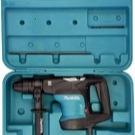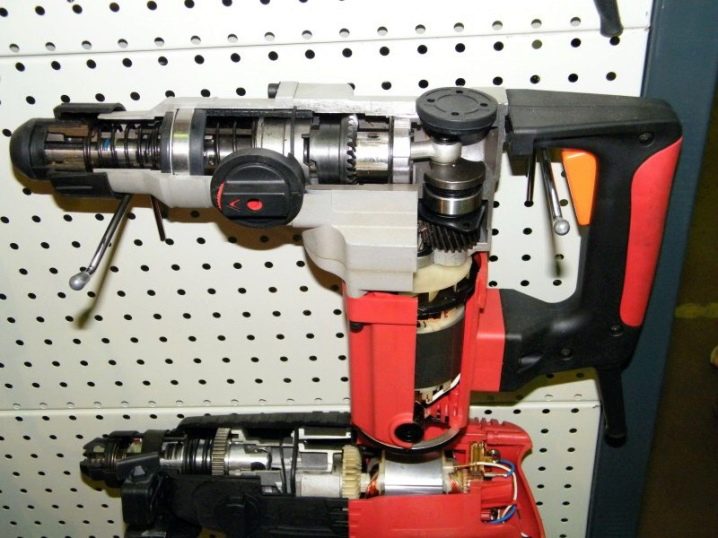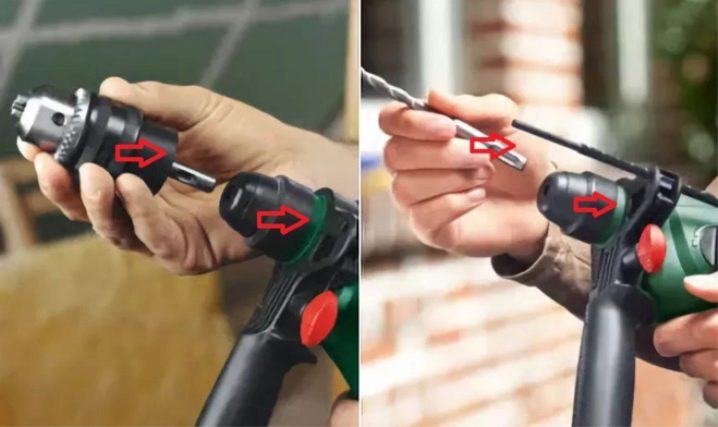How to repair a Makita Rotary Hammer?

The Makita hammer drill is a Japanese representative of repair equipment that can be used both at home and in professional activities. In the assembly of this power tool, only high-quality materials are used that meet international quality certificates.
What you should know about the Makita tool, what information to have, we will consider further.

Design
The difference between a conventional drill and a rock drill is that the rock drill has a strong impact function, which helps to work with tougher materials. The pushing power of the tool allows the craftsman to waste less physical strength. One of the reliable assistants in the household, solving household and repair problems, is the representative of Makita electrical equipment.
Makita device consists of mechanized and electrical parts. Its body is divided into two colors: black and green. Under the black part there is a mechanical unit, and under the green part there is an electrical unit of the installation.

The mechanical half is responsible for the following functions:
- shaft torque supply;
- torque;
- shock push;
- transfer of torsion from the rotor to the tool itself.

The wiring diagram is represented by a rotor, a stator, carbon brushes, a brush holder, a switch.
Makita power tools are the most powerful construction equipment for heavy, intense loads, with three functions: drilling, crushing, hammer drilling. The device has anti-vibration, which is not typical for every instrument. The assembly has an individual dust protection system.
Specifications:
- weight - 2.04 kg;
- SDS-system makes it possible to mount drills;
- beats 4500 beats per minute;
- power of movement - 2.7 J;
- power supply from the network - 780 W.






Instrument disassembly and assembly procedure
Before proceeding with the punching drill, you need to stock up on a tool that you cannot do without: hexagons, screwdrivers with various cuts (minus, cross, curly), special bearing pullers, vices.
It is advisable to have on hand spare parts that may be needed to replace old ones, as well as lubricants and cleaning agents.
Always useful:
- grease, solvent;
- spare brushes (if replacement is needed);
- copper wire of a suitable cross-section.

It is not difficult to disassemble the unit, the main thing is to follow the instructions and be as careful as possible. It is necessary to observe safety precautions, before starting work, unplug the tool from the mains.
Disassembly
First you need to remove the quick-release master. After dismantling, remove the four screws that secure the "body" of the mechanical gearbox. Next, press the gable of the shaft, remove the black cover. Then pull the mechanized unit out of the green side, this requires the following manipulations:
- in the handle, remove the three screws that hold the cover;
- dismantle the cover;
- remove the carbon brushes, release the brush holder springs.


After all the steps taken, pull out the mechanical stator block. Free the rotor.
Then you should disassemble the shock unit mechanics block, unscrew the two bolts located in the housing foundation.
Now it's time to remove the intermediate shaft, you will need to remove it from it in order:
- ring, bearing;
- spur gear;
- friction bearing;
- the washer is flat;
- 606 bearing;
- S-7 retaining ring;
- compression spiral;
- clutch.


Next, remove the barrel shaft of the chiseling mechanism. It is necessary to remove it from the inside of the housing, and remove the cylinder from the shaft itself.
Continuing to carry out the parsing sequence, dismantle it by following the following points of the instructions:
- knock out the piston connector;
- remove flat washers;
- remove the drummer.

To expand the shaft itself, you will need to remove the washer, compression and annular springs, a steel ball, and a spur gear. And from the inner cavity, remove the metal and rubber (2 pcs.) Rings, an annular spring, a ring, a flat washer made of metal.
Observing all the rules for the sequence of disassembly, we proceed to dismantle the electrical part, which includes the following parts:
- stator;
- switch;
- rotor;
- carbon brushes;
- brush holder.

Then you need to remove the two self-tapping screws.
To remove the stator, simply tap on the side of the green housing, for example, with a piece of wood. The rest of the parts of the electrical device can be pulled out quite easily, since they are not attached to anything.
Assembly
Before returning all the parts that make up the hammer drill, apply a new layer of grease. Clean the housing with petrol. If necessary, change all parts that need to be replaced, varnish the coils. Degrease the collector with a cotton pad moistened with alcohol solution to avoid dust adhesion to the lubricated bearing. Collect everything in reverse order.
It may need to be repaired, serviced, prevented or even replaced.
You need to know not only the rules for disassembly and assembly, but also be able to troubleshoot minor problems.

Causes of breakdowns
Even devices of very good quality fail during long-term operation, wear out, and need to be replaced with various spare parts. Before starting the repair, you need to conduct a complete inspection of the device, as well as understand the causes of the breakdown.
Let's present several options for common problems:
- filling with dirt, dust, moisture;
- the lubricant inside the device hardens during long-term operation, respectively, it no longer works as intended;
- after a while, the instrument begins to emit excessive noise, which indicates that repair is required;
- heavy loads, long-term use in construction needs, overheating, an unpleasant odor emanates from the inside;
- Frequent mode switching over time will cause the switch button to flap.

With this information, you can avoid serious breakdowns, as well as prevent their occurrence by ensuring timely repairs.
How do I change the cartridge?
Before changing the cartridge, it is worth trying to repair it - in most cases this is enough. But if individual parts are damaged, and the cartridge itself is very worn out, then it should be replaced, by following these steps:
- screw the cartridge onto the drill;
- insert the screw into the slot;
- tighten using a screwdriver.

How to insert a drill?
It is not difficult to perform this operation, the main thing is to follow the correct sequence of actions:
- insert the drill into the chuck;
- rotate the upper part clockwise until it stops;
- fix the drill.

After the performed actions, it is imperative to check the stability and quality of the drill attachment.
Replacing brushes
The need to replace the brushes is identified based on such signs as significant overheating of the installation site where the electric brushes are located. It is recommended to replace them only if they are completely worn out.... Replacement is done using an electrical screwdriver. The process will not take much time if dismantled correctly (disassembly steps are given above).Pre-purchased new brushes are inserted in place of worn-out ones.
In some Makita models, the clamping mechanism is different - the spring is in the form of a spiral, so you will need to remove it during replacement.

Troubleshooting
No matter how reliable and high-quality a Makita tool is, breakdown and failure are possible over time. Any damage can be repaired if preventive repairs are carried out in a timely manner. Both mechanical and electrical parts can fail.

Doesn't turn the cartridge
If during operation the equipment cracks, does not twist the cartridge, then, possibly, damage has occurred in the engine. In order to understand the reason, you will need to disassemble the mechanics. If the problem is not the engine, it is most likely the engine.
Options: scrapping the start button, closing the coils.
Using the tester, you can pinpoint the causes of failure and eliminate them.

Does not hold a drill in a chuck
Disassemble the cartridge to find out what the problem is. Most likely - this is aging, damage to the cartridge. Maybe the fixing spring has sagged, the balls have lost their shape, and so on.
Usually, replacing obsolete or faulty parts allows you to fix this kind of breakdown.

Replacing the anchor
Removing the anchor is easy if you follow a certain sequence:
- detach the back cover, detach the brushes;
- unscrew the gearbox housing, clean all parts from dust;
- then you should remove the anchor by slightly pulling it towards you, and put a new part in its place;
- before placing a new anchor, do not forget to put on rubber shock absorbers, change the air intake plate;
- Replace all previously removed parts in reverse order.

The tool does not hammer
Most likely, the floating bearing has broken, it will need to be replaced. The problem may also be related to the violation of the impact. It appears during long-term operation, which causes the striker to split. In this case, it must be changed.
Another type of breakdown is the aging of the piston group. It is necessary to replace the piston and liner.

Replacing the start button
The process includes the following steps:
- remove the cover covering the equipment;
- disconnect the contacts of the conductors;
- pull the button body out of the place where it is and put a new button;
- connect the contacts, collecting everything in the reverse order.

Overheating in use
If you follow all the rules for using the punch, namely: take breaks during use, let the device run idle, then there will be no overheating. But if this has already happened, then you need to check the electric motor.
If there is a burning smell, it is necessary to immediately disconnect the tool from the mains.
Disassemble the device after complete cooling, check the integrity of the motor, and if it is damaged, replace it.

Advice
With proper care and periodic cleaning of the tool, its service life will significantly increase. It will not be superfluous to observe some of the rules for operating the hammer drill in order to reduce the risk of malfunctions.
- Inspect the condition of the device before use.
- After completing the work, clean the device from dirt. You can use an air jet, for example, from a vacuum cleaner.
- If it is necessary to transport it during the cold season to work with an electrical device, allow it to warm up before use (the grease must thaw).
- Adhere to the operating standards specified in the instructions.
- Store the instrument in a warm, dry place.
- Avoid moisture and condensation from the air.
- If the device is not used for a long time, it is better to store it in plastic and a cardboard box.

How to troubleshoot a Makita hammer drill is the following video.













The comment was sent successfully.